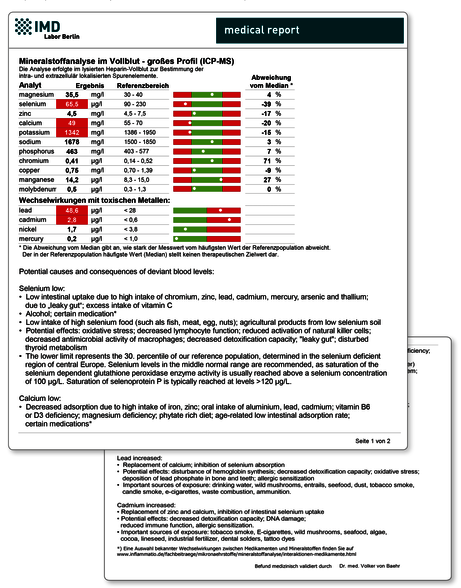Mineral Analysis in Whole Blood (EDTA/Heparin)
Identifying deficiencies, but avoiding overdoses
As cofactors of enzymes, trace elements play important roles in various metabolic processes. Even latent shortages may lead to subtle impairments of physiological processes, such as reduced cognitive abilities, increased susceptibility to infection, or chronic inflammation.
Excess intake of trace elements on the other hand may have toxic effects. Diagnostics of trace element supply helps identifying deficiencies and avoids oversupplies.
Why is haematocrit correction not recommended?
Some laboratories use the ratio of mineral levels and haematocrit as an indicator, but mineral deficiencies may in fact remain undetected in cases of reduced cell counts (particularly anaemia). Mineral deficiency itself may compromise hematopoiesis. Moreover, many trace elements, like selenium and copper, are located intra- and extracellularly, or their distribution may vary among patients. The intracellular distribution of other minerals, such as chromium, manganese and molybdenum, is unknown. “Normalising” values with respect to the haematocrit may distort the result and disguise mineral deficiencies.
Interactions between minerals and toxic metals should be taken into consideration
Some toxic metals show binding affinities similar to those of trace elements. This leads to competition between toxic minerals and trace elements at enzymatic binding sites. This type of antagonism has been identified for cadmium and zinc, nickel and magnesium, as well as for lead and calcium. Mercury binds to selenium with high affinity und thus inhibits its effect. Arsenic promotes selenium excretion. Therefore, a parallel detection of toxic elements provides crucial additional information ontrace element status.
Fig. 1 Mineral analysis in lysed whole blood allows for the assessment of the overall level of supply both for primarily intra- and extracellular minerals. A haematocrit correction is not indicated, since results for most metals are distorted.
Analytics
Analysis is conducted using inductively coupled plasma mass spectrometry (ICP-MS).
| mineral profile | material | scale of fees for physicians (GOÄ) | content |
|---|---|---|---|
| „7+2“ | EDTA or Li-heparin blood | 50.13 € | magnesium, selenium, zinc, chromium, cooper, manganese, molybdenum + cadmium, nickel |
| „11+4“ | Li-heparin blood | 61.79 € | magnesium, selenium, zinc, calcium, potassium, sodium, phosphorus, chromium, copper, manganese, molybdenum + lead, cadmium, nickel, mercury |
| „11+6“ | Li- heparin blood | 81.03 € | magnesium, selenium, zinc, calcium, potassium, sodium, phosphorus, chromium, copper, manganese, molybdenum + aluminium, arsenic, lead, cadmium, nickel, mercury |

Sample report “Mineral Analysis – 11+4 Profile (large profile)”. Please find other profiles in the table on the recto.
Literature
- Hartmann M und Hartwig A. Disturbance of DNA damage recognition after UV-irradiation by nickel(II) and cadmium(II) in mammalian cells. Carcinogenesis 1998; 19: 617-621.
- Jennrich P. Schwermetalle – Ursache für Zivilisationskrankheiten. CO’MED 2007.
- Thomas L. Labor und Diagnose. TH-Books Verlagsgesellschaft 2012.
- Löffler BM, Die Calcium-Magnesium defiziente Bevölkerung: Vitamin D3 allein ist nicht genug. OM& Ernährung 2014.
Would you like to see a presentation on the matter?
In our video archive, you can find a presentation on this topic. Access is free and does not require prior registration.

